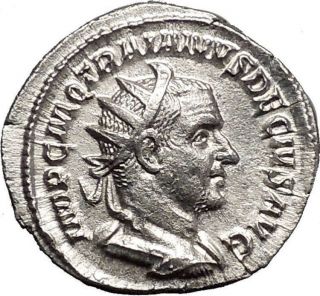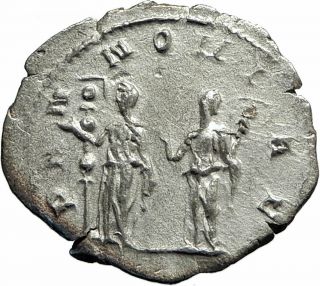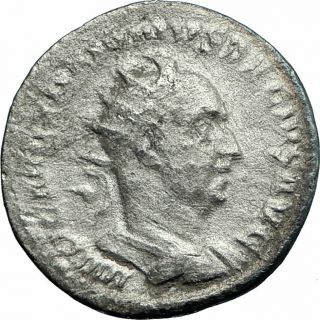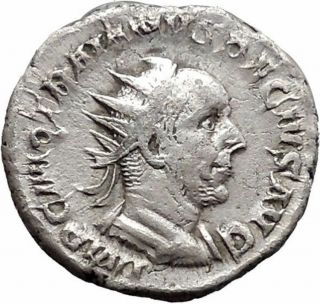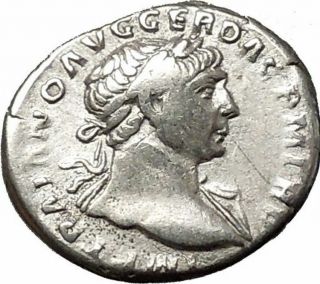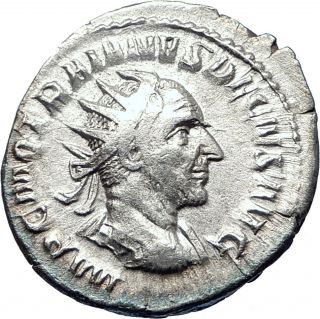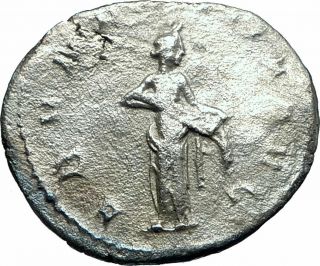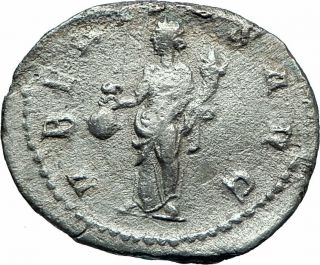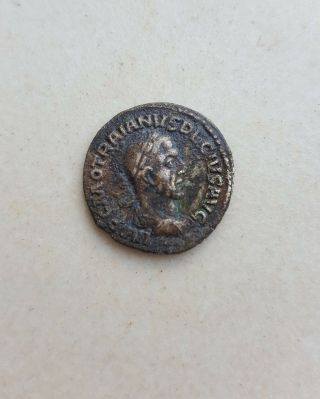TRAJAN DECIUS 250AD Silver Ancient Roman Coin Pannonia Roman Province I49823
Item History & Price
| Reference Number: Avaluer:26073196 | Ruler: Trajan Decius |
| Composition: Silver |
Item: i49823
Authentic Ancient Coin of: Trajan Decius -Roman Emperor : 249-251 A.D. -
Silver Antoninianus 22mm (4.08 grams) Rome mint: 250 A.D.
Reference: RIC 21b, C 86
IMPCMQTRAIANVSDECIVSAVG - Radiate, draped and cuirassed bust right.
PANNONIAE - Two Pannoniae standing facing, each rais...ing a hand; Pannonia on left has standard
behind her, one on right is holding a standard.
You are bidding on the exact item pictured, provided with a Certificate of Authenticity and Lifetime Guarantee of Authenticity. Pannonia was an ancient province of theRoman Empire bounded north and east by theDanube, coterminous westward withNoricum and upperItaly, and southward withDalmatia and upperMoesia. Pannonia was located over the territory of the present-day westernHungary, easternAustria, northernCroatia, north-westernSerbia, Slovenia, westernSlovakia and northernBosnia and Herzegovina.Julius Pokorny derived the name Pannonia fromIllyrian, from theProto-Indo-European root *pen-, "swamp, water, wet" (cf. English fen, "marsh"; Hindi pani, "water").History Further information: Prehistoric Hungary , Prehistoric Croatia, Prehistoric Serbia, Prehistoric Slovenia, Prehistoric Bosnia and Herzegovina, Prehistoric Austria, and Prehistoric SlovakiaThe first inhabitants of this area known to history were the Pannonii (Pannonians), a group ofIndo-European tribes akin toIllyrians. From the 4th century BC it was invaded by various Celtic tribes. Little is heard of Pannonia until 35 BC, when its inhabitants, allies of theDalmatians, were attacked byAugustus, who conquered and occupied Siscia (Sisak). The country was not, however, definitely subdued by the Romans until 9 BC, when it was incorporated intoIllyricum, the frontier of which was thus extended as far as the Danube.In AD 6, the Pannonians, with the Dalmatians and other Illyrian tribes, engaged in the so-calledGreat Illyrian Revolt, and were overcome byTiberius andGermanicus, after a hard-fought campaign which lasted for three years. After the rebellion was crushed in AD 9, the province of Illyricum was dissolved, and its lands were divided between the new provinces of Pannonia in the north andDalmatia in the south. The date of the division is unknown, most certainly after AD 20 but before AD 50. The proximity of dangerous barbarian tribes (Quadi, Marcomanni) necessitated the presence of a large number of troops (seven legions in later times), and numerous fortresses were built on the bank of the Danube.Some time between the years 102 and 107, between the first and second Dacian war, Trajan divided theprovince intoPannonia Superior (western part with the capital Carnuntum), andPannonia Inferior (eastern part with the capitals in Aquincum andSirmium[8]). According to Ptolemy, these divisions were separated by a line drawn fromArrabona in the north toServitium in the south; later, the boundary was placed further east. The whole country was sometimes called the Pannonias (Pannoniae).Pannonia Superior was under the consular legate, who had formerly administered the single province, and had three legions under his control; Pannonia Inferior at first under a praetorian legate with a single legion as garrison, afterMarcus Aurelius under a consular legate, still with only one legion. The frontier on the Danube was protected by the establishment of the two coloniesAelia Mursia andAelia Aquincum byHadrian.Under Diocletian a fourfold division of the country was made: Pannonia Prima in the northwest, with capital in Savaria / Sabaria , Pannonia Valeria in the northeast, with capital in Sopianae , Pannonia Savia in the southwest, with capital in Siscia , Pannonia Secunda in the southeast, with capital in Sirmium Diocletian also moved parts of today'sSlovenia out of Pannonia and incorporated them in Noricum.Constantine I enlarged in 324 AD the borders of Roman Pannonia to the east, annexing the plains of what is now eastern Hungary, northern Serbia and western Romania up to thelimes that he created: theDevil's Dykes.In the 4th-5th century, one of the dioceses of the Roman Empire was known as theDiocese of Pannonia. It had capital inSirmium and included all four provinces that were formed from historical Pannonia, as well as provinces ofDalmatia, Noricum Mediterraneum andNoricum Ripensis.In the middle of the 5th century, Pannonia was ceded to theHuns byTheodosius II, and after the death ofAttila successively passed (entirely or partially) into the hands of theOstrogoths (456–6th century), Lombards (530–68), Gepids (6th century), Byzantine Empire (6th century and 11th-12th century), Avars (560s – c.800), various Slavic states (Slavs living there since c. 480s; independent since 7th century), Franks (8th-9th century), Magyars (since 900/901), Holy Roman Empire (since 10th century), Habsburgs (since 14th century), Ottomans (since 1512; the Ottoman administration ended in 1878) andSerbia (since 19th century). After theFirst World War, the region was divided betweenAustria, Hungary theKingdom of Serbs, Croats and Slovenes (renamed to Yugoslavia in 1929) andCzechoslovakia.During the first period of Byzantine administration in the 6th century, province namedPannonia (with capital inSirmium) was temporarily restored, but it included only small south-eastern part of historical Pannonia. In the second period of Byzantine administration (11th century) an province namedTheme of Sirmium (also with capital inSirmium) was established in this same area. An Frankish frontier march namedMarch of Pannonia was established in the end of the 8th century, while termsLower andUpper Pannonia were also used in the 9th century as a designations foran Slavic principality andan Frankish province.Furthermore, between the 5th and the 10th century the romanized population of Pannonia developed theRomance Pannonian Language, mainly around thelake Balaton in present-day western Hungary, where there was thekeszthely culture. This language and the related culture were extinct with thearrival of the Magyars.Gaius Messius Quintus Decius (ca. 201- June 251) was theEmperor of Rome from 249 to 251. In the last year of his reign, he co-ruled with his sonHerennius Etruscus until both of them were killed in theBattle of Abrittus.// Early life and rise to powerDecius, who was born atBudalia, nowMartinci, Serbia nearSirmium (Sremska Mitrovica), inLower Pannonia was one of the first among a long succession of future Roman Emperors to originate from the provinces ofIllyria in the Danube.[1]. Unlike some of his immediate imperial predecessors such as Philip the Arab orMaximinus, Decius was a distinguished senator who had served asconsul in 232, had been governor ofMoesia andGermania Inferior soon afterwards, served as governor ofHispania Tarraconensis between 235-238, and wasurban prefect of Rome during the early reign of EmperorPhilip the Arab (Marcus Iulius Phillipus).Around 245, Emperor Philip entrusted Decius with an important command on the Danube. By the end of 248 or 249, Decius was sent to quell the revolt ofPacatianus and his troops in Moesia and Pannonia[3]; the soldiers were enraged because of the peace treaty signed between Philip and theSassanids. Once arrived, the troops forced Decius to assume the imperial dignity himself instead. Decius still protested his loyalty to Philip, but the latter advanced against him and was killed nearVerona, Italy. TheSenate then recognized Decius as Emperor, giving him the attribute Traianus as a reference to the good emperorTrajan. As the Byzantine historianZosimus later noted: Decius was therefore clothed in purple and forced to undertake the [burdens of] government, despite his reluctance and unwillingness. Political and monumental initiativesDecius' political program was focused on the restoration of the strength of the State, both military opposing the external threats, and restoring the public piety with a program of renovation of theState religion.Either as a concession to the Senate, or perhaps with the idea of improving public morality, Decius endeavoured to revive the separate office and authority of thecensor. The choice was left to the Senate, who unanimously selectedValerian (afterwards emperor). But Valerian, well aware of the dangers and difficulties attaching to the office at such a time, declined the responsibility. The invasion of theGoths and Decius' death put an end to the abortive attempt.During his reign, he proceeded to construct several building projects in Rome "including the Thermae Deciane or Baths of Decius on the Aventine" which was completed in 252 and still survived through to the16th century; Decius also acted to repair the Colosseum, which had been damaged by lightning strikes. Persecution of Christians Main article: Decian persecution In January 250, Decius issued an edict for the suppression ofChristianity. The edict itself was fairly clear: All the inhabitants of the empire were required to sacrifice before the magistrates of their community 'for the safety of the empire' by a certain day (the date would vary from place to place and the order may have been that the sacrifice had to be completed within a specified period after a community received the edict). When they sacrificed they would obtain a certificate (libellus) recording the fact that they had complied with the order.While Decius himself may have intended the edict as a way to reaffirm his conservative vision of the Pax Romana and to reassure Rome's citizens that the empire was still secure, it nevertheless sparked a "terrible crisis of authority as various [Christian] bishops and their flocks reacted to it in different ways." Measures were first taken demanding that the bishops and officers of the church make a sacrifice for the Emperor, a matter of an oath of allegiance that Christians considered offensive. Certificates were issued to those who satisfied thepagan commissioners during the persecution of Christians under Decius. Forty-six such certificates have been published, all dating from 250, four of them fromOxyrhynchus. Christian followers who refused to offer a pagan sacrifice for the Emperor and the Empire's well-being by a specified date risked torture and execution. A number of prominent Christians did, in fact, refuse to make a sacrifice and were killed in the process includingPope Fabian himself in 250 and "anti-Christian feeling[s] led to pogroms at Carthage and Alexandria." In reality, however, towards the end of the second year of Decius' reign, "the ferocity of the [anti-Christian] persecution had eased off, and the earlier tradition of tolerance had begun to reassert itself." The Christian church though never forgot the reign of Decius whom they labelled as that "fierce tyrant".At this time, there was a second outbreak of theAntonine Plague, which at its height in 251 to 266 took the lives of 5, 000 a day in Rome. This outbreak is referred to as the "Plague ofCyprian" (the bishop of Carthage), where both the plague and thepersecution of Christians were especially severe. Cyprian's biographerPontius gave a vivid picture of the demoralizing effects of the plague and Cyprian moralized the event in his essay De mortalitate. In Carthage the "Decian persecution" unleashed at the onset of the plague sought out Christian scapegoats. Decius' edicts were renewed under Valerius in 253 and repealed under his son, Gallienus, in 260-1. Military actions and deathThebarbarian incursions into the Empire were becoming more and more daring and frequent whereas the Empire was facing a serious economic crisis in Decius' time. During his brief reign, Decius engaged in important operations against theGoths, who crossed the Danube to raid districts of Moesia andThrace. This is the first considerable occasion the Goths — who would later come to play such an important role — appear in the historical record. The Goths under KingCniva were surprised by the emperor while besiegingNicopolis on the Danube; the Goths fled through the difficult terrain of theBalkans, but then doubled back and surprised the Romans near Beroë (modernStara Zagora), sacking their camp and dispersing the Roman troops. It was the first time a Roman emperor fled in the face of Barbarians. The Goths then moved toPhilippopolis attack (modernPlovdiv), which fell into their hands. The governor of Thrace, Titus Julius Priscus, declared himself Emperor under Gothic protection in opposition to Decius but Priscus's challenge was rendered moot when he was killed soon afterwards.The siege of Philippopolis had so exhausted the numbers and resources of the Goths that they offered to surrender their treasure and prisoners, on condition of being allowed to retire.[ neededcitation] Decius, who had succeeded in surrounding them and hoped to cut off their retreat, refused to entertain their proposals. The final engagement, in which the Goths fought with the courage of despair, under the command of Cniva, took place during the second week of June 251 on swampy ground in the Ludogorie (region in northeastern Bulgaria which merges with Dobruja plateau and the Danube Plain to the north) near the small settlement of Abrittus or Forum Terebronii (modernRazgrad): seeBattle of Abrittus.Jordanes records that Decius' sonHerennius Etruscus was killed by an arrow early in the battle, and to cheer his men Decius exclaimed, "Let no one mourn; the death of one soldier is not a great loss to the republic." Nevertheless, Decius' army was entangled in the swamp and annihilated in this battle, while he himself was killed on the field of battle. As the historianAurelius Victor relates: The Decii (ie. Decius), while pursuing the barbarians across the Danube, died through treachery at Abrittus after reigning two years....Very many report that the son had fallen in battle while pressing an attack too boldly; that the father however, has strenuously asserted that the loss of one soldier seemed to him too little to matter. And so he resumed the war and died in a similar manner while fighting vigorously.One literary tradition claims that Decius was betrayed by his successorTrebonianus Gallus, who was involved in a secret alliance with the Goths but this cannot be substantiated and was most likely a later invention since Gallus felt compelled to adopt Decius' younger son, Gaius Valens Hostilianus, as joint emperor even though the latter was too young to rule in his own right. It is also unlikely that the shattered Roman legions would proclaim as emperor a traitor who was responsible for the loss of so many soldiers from their ranks. Decius was the first Roman emperor to die in battle against a foreign enemy Frequently Asked Questions How long until my order is shipped?
Depending on the volume of sales, it may take up to 5 business days forshipment of your order after the receipt of payment. How will I know when the order was shipped?
After your order has shipped, you will be left positive feedback, and thatdate should be used as a basis of estimating an arrival date. After you shipped the order, how long will the mail take?
USPS First Class mail takes about 3-5 business days to arrive in the U.S., international shipping times cannot be estimated as they vary from countryto country. I am not responsible for any USPS delivery delays, especiallyfor an international package. What is a certificate of authenticity and what guarantees do you givethat the item is authentic?
Each of the items sold here, is provided with a Certificate of Authenticity, and a Lifetime Guarantee of Authenticity, issued by a world-renowned numismatic and antique expert that has identified over 10000 ancient coins and has provided themwith the same guarantee. You will be quite happy with what you get with the COA; a professional presentation of the coin, with all of the relevantinformation and a picture of the coin you saw in the listing. Compared to other certification companies, the certificate of authenticity is a $25-50 value. So buy a coin today and own a piece of history, guaranteed. Is there a money back guarantee?
I offer a 30 day unconditional money back guarantee. I stand behind my coins and would be willing to exchange your order for either store credit towards other coins, or refund, minus shipping expenses, within 30 days from the receipt of your order. My goal is to have the returning customers for a lifetime, and I am so sure in my coins, their authenticity, numismatic value and beauty, I can offer such a guarantee. Is there a number I can call you with questions about my order? You can contact me directly via ask seller a question and request my telephone number, or go to my About Me Page to get my contact information only in regards to items purchased on eBay. When should I leave feedback?
Once you receive your order, please leave a positive. Please don't leave anynegative feedbacks, as it happens many times that people rush to leavefeedback before letting sufficient time for the order to arrive. Also, ifyou sent an email, make sure to check for my reply in your messages beforeclaiming that you didn't receive a response. The matter of fact is that anyissues can be resolved, as reputation is most important to me. My goal is toprovide superior products and quality of service.
02427
Authentic Ancient Coin of: Trajan Decius -Roman Emperor : 249-251 A.D. -
Silver Antoninianus 22mm (4.08 grams) Rome mint: 250 A.D.
Reference: RIC 21b, C 86
IMPCMQTRAIANVSDECIVSAVG - Radiate, draped and cuirassed bust right.
PANNONIAE - Two Pannoniae standing facing, each rais...ing a hand; Pannonia on left has standard
behind her, one on right is holding a standard.
You are bidding on the exact item pictured, provided with a Certificate of Authenticity and Lifetime Guarantee of Authenticity. Pannonia was an ancient province of theRoman Empire bounded north and east by theDanube, coterminous westward withNoricum and upperItaly, and southward withDalmatia and upperMoesia. Pannonia was located over the territory of the present-day westernHungary, easternAustria, northernCroatia, north-westernSerbia, Slovenia, westernSlovakia and northernBosnia and Herzegovina.Julius Pokorny derived the name Pannonia fromIllyrian, from theProto-Indo-European root *pen-, "swamp, water, wet" (cf. English fen, "marsh"; Hindi pani, "water").History Further information: Prehistoric Hungary , Prehistoric Croatia, Prehistoric Serbia, Prehistoric Slovenia, Prehistoric Bosnia and Herzegovina, Prehistoric Austria, and Prehistoric SlovakiaThe first inhabitants of this area known to history were the Pannonii (Pannonians), a group ofIndo-European tribes akin toIllyrians. From the 4th century BC it was invaded by various Celtic tribes. Little is heard of Pannonia until 35 BC, when its inhabitants, allies of theDalmatians, were attacked byAugustus, who conquered and occupied Siscia (Sisak). The country was not, however, definitely subdued by the Romans until 9 BC, when it was incorporated intoIllyricum, the frontier of which was thus extended as far as the Danube.In AD 6, the Pannonians, with the Dalmatians and other Illyrian tribes, engaged in the so-calledGreat Illyrian Revolt, and were overcome byTiberius andGermanicus, after a hard-fought campaign which lasted for three years. After the rebellion was crushed in AD 9, the province of Illyricum was dissolved, and its lands were divided between the new provinces of Pannonia in the north andDalmatia in the south. The date of the division is unknown, most certainly after AD 20 but before AD 50. The proximity of dangerous barbarian tribes (Quadi, Marcomanni) necessitated the presence of a large number of troops (seven legions in later times), and numerous fortresses were built on the bank of the Danube.Some time between the years 102 and 107, between the first and second Dacian war, Trajan divided theprovince intoPannonia Superior (western part with the capital Carnuntum), andPannonia Inferior (eastern part with the capitals in Aquincum andSirmium[8]). According to Ptolemy, these divisions were separated by a line drawn fromArrabona in the north toServitium in the south; later, the boundary was placed further east. The whole country was sometimes called the Pannonias (Pannoniae).Pannonia Superior was under the consular legate, who had formerly administered the single province, and had three legions under his control; Pannonia Inferior at first under a praetorian legate with a single legion as garrison, afterMarcus Aurelius under a consular legate, still with only one legion. The frontier on the Danube was protected by the establishment of the two coloniesAelia Mursia andAelia Aquincum byHadrian.Under Diocletian a fourfold division of the country was made: Pannonia Prima in the northwest, with capital in Savaria / Sabaria , Pannonia Valeria in the northeast, with capital in Sopianae , Pannonia Savia in the southwest, with capital in Siscia , Pannonia Secunda in the southeast, with capital in Sirmium Diocletian also moved parts of today'sSlovenia out of Pannonia and incorporated them in Noricum.Constantine I enlarged in 324 AD the borders of Roman Pannonia to the east, annexing the plains of what is now eastern Hungary, northern Serbia and western Romania up to thelimes that he created: theDevil's Dykes.In the 4th-5th century, one of the dioceses of the Roman Empire was known as theDiocese of Pannonia. It had capital inSirmium and included all four provinces that were formed from historical Pannonia, as well as provinces ofDalmatia, Noricum Mediterraneum andNoricum Ripensis.In the middle of the 5th century, Pannonia was ceded to theHuns byTheodosius II, and after the death ofAttila successively passed (entirely or partially) into the hands of theOstrogoths (456–6th century), Lombards (530–68), Gepids (6th century), Byzantine Empire (6th century and 11th-12th century), Avars (560s – c.800), various Slavic states (Slavs living there since c. 480s; independent since 7th century), Franks (8th-9th century), Magyars (since 900/901), Holy Roman Empire (since 10th century), Habsburgs (since 14th century), Ottomans (since 1512; the Ottoman administration ended in 1878) andSerbia (since 19th century). After theFirst World War, the region was divided betweenAustria, Hungary theKingdom of Serbs, Croats and Slovenes (renamed to Yugoslavia in 1929) andCzechoslovakia.During the first period of Byzantine administration in the 6th century, province namedPannonia (with capital inSirmium) was temporarily restored, but it included only small south-eastern part of historical Pannonia. In the second period of Byzantine administration (11th century) an province namedTheme of Sirmium (also with capital inSirmium) was established in this same area. An Frankish frontier march namedMarch of Pannonia was established in the end of the 8th century, while termsLower andUpper Pannonia were also used in the 9th century as a designations foran Slavic principality andan Frankish province.Furthermore, between the 5th and the 10th century the romanized population of Pannonia developed theRomance Pannonian Language, mainly around thelake Balaton in present-day western Hungary, where there was thekeszthely culture. This language and the related culture were extinct with thearrival of the Magyars.Gaius Messius Quintus Decius (ca. 201- June 251) was theEmperor of Rome from 249 to 251. In the last year of his reign, he co-ruled with his sonHerennius Etruscus until both of them were killed in theBattle of Abrittus.// Early life and rise to powerDecius, who was born atBudalia, nowMartinci, Serbia nearSirmium (Sremska Mitrovica), inLower Pannonia was one of the first among a long succession of future Roman Emperors to originate from the provinces ofIllyria in the Danube.[1]. Unlike some of his immediate imperial predecessors such as Philip the Arab orMaximinus, Decius was a distinguished senator who had served asconsul in 232, had been governor ofMoesia andGermania Inferior soon afterwards, served as governor ofHispania Tarraconensis between 235-238, and wasurban prefect of Rome during the early reign of EmperorPhilip the Arab (Marcus Iulius Phillipus).Around 245, Emperor Philip entrusted Decius with an important command on the Danube. By the end of 248 or 249, Decius was sent to quell the revolt ofPacatianus and his troops in Moesia and Pannonia[3]; the soldiers were enraged because of the peace treaty signed between Philip and theSassanids. Once arrived, the troops forced Decius to assume the imperial dignity himself instead. Decius still protested his loyalty to Philip, but the latter advanced against him and was killed nearVerona, Italy. TheSenate then recognized Decius as Emperor, giving him the attribute Traianus as a reference to the good emperorTrajan. As the Byzantine historianZosimus later noted: Decius was therefore clothed in purple and forced to undertake the [burdens of] government, despite his reluctance and unwillingness. Political and monumental initiativesDecius' political program was focused on the restoration of the strength of the State, both military opposing the external threats, and restoring the public piety with a program of renovation of theState religion.Either as a concession to the Senate, or perhaps with the idea of improving public morality, Decius endeavoured to revive the separate office and authority of thecensor. The choice was left to the Senate, who unanimously selectedValerian (afterwards emperor). But Valerian, well aware of the dangers and difficulties attaching to the office at such a time, declined the responsibility. The invasion of theGoths and Decius' death put an end to the abortive attempt.During his reign, he proceeded to construct several building projects in Rome "including the Thermae Deciane or Baths of Decius on the Aventine" which was completed in 252 and still survived through to the16th century; Decius also acted to repair the Colosseum, which had been damaged by lightning strikes. Persecution of Christians Main article: Decian persecution In January 250, Decius issued an edict for the suppression ofChristianity. The edict itself was fairly clear: All the inhabitants of the empire were required to sacrifice before the magistrates of their community 'for the safety of the empire' by a certain day (the date would vary from place to place and the order may have been that the sacrifice had to be completed within a specified period after a community received the edict). When they sacrificed they would obtain a certificate (libellus) recording the fact that they had complied with the order.While Decius himself may have intended the edict as a way to reaffirm his conservative vision of the Pax Romana and to reassure Rome's citizens that the empire was still secure, it nevertheless sparked a "terrible crisis of authority as various [Christian] bishops and their flocks reacted to it in different ways." Measures were first taken demanding that the bishops and officers of the church make a sacrifice for the Emperor, a matter of an oath of allegiance that Christians considered offensive. Certificates were issued to those who satisfied thepagan commissioners during the persecution of Christians under Decius. Forty-six such certificates have been published, all dating from 250, four of them fromOxyrhynchus. Christian followers who refused to offer a pagan sacrifice for the Emperor and the Empire's well-being by a specified date risked torture and execution. A number of prominent Christians did, in fact, refuse to make a sacrifice and were killed in the process includingPope Fabian himself in 250 and "anti-Christian feeling[s] led to pogroms at Carthage and Alexandria." In reality, however, towards the end of the second year of Decius' reign, "the ferocity of the [anti-Christian] persecution had eased off, and the earlier tradition of tolerance had begun to reassert itself." The Christian church though never forgot the reign of Decius whom they labelled as that "fierce tyrant".At this time, there was a second outbreak of theAntonine Plague, which at its height in 251 to 266 took the lives of 5, 000 a day in Rome. This outbreak is referred to as the "Plague ofCyprian" (the bishop of Carthage), where both the plague and thepersecution of Christians were especially severe. Cyprian's biographerPontius gave a vivid picture of the demoralizing effects of the plague and Cyprian moralized the event in his essay De mortalitate. In Carthage the "Decian persecution" unleashed at the onset of the plague sought out Christian scapegoats. Decius' edicts were renewed under Valerius in 253 and repealed under his son, Gallienus, in 260-1. Military actions and deathThebarbarian incursions into the Empire were becoming more and more daring and frequent whereas the Empire was facing a serious economic crisis in Decius' time. During his brief reign, Decius engaged in important operations against theGoths, who crossed the Danube to raid districts of Moesia andThrace. This is the first considerable occasion the Goths — who would later come to play such an important role — appear in the historical record. The Goths under KingCniva were surprised by the emperor while besiegingNicopolis on the Danube; the Goths fled through the difficult terrain of theBalkans, but then doubled back and surprised the Romans near Beroë (modernStara Zagora), sacking their camp and dispersing the Roman troops. It was the first time a Roman emperor fled in the face of Barbarians. The Goths then moved toPhilippopolis attack (modernPlovdiv), which fell into their hands. The governor of Thrace, Titus Julius Priscus, declared himself Emperor under Gothic protection in opposition to Decius but Priscus's challenge was rendered moot when he was killed soon afterwards.The siege of Philippopolis had so exhausted the numbers and resources of the Goths that they offered to surrender their treasure and prisoners, on condition of being allowed to retire.[ neededcitation] Decius, who had succeeded in surrounding them and hoped to cut off their retreat, refused to entertain their proposals. The final engagement, in which the Goths fought with the courage of despair, under the command of Cniva, took place during the second week of June 251 on swampy ground in the Ludogorie (region in northeastern Bulgaria which merges with Dobruja plateau and the Danube Plain to the north) near the small settlement of Abrittus or Forum Terebronii (modernRazgrad): seeBattle of Abrittus.Jordanes records that Decius' sonHerennius Etruscus was killed by an arrow early in the battle, and to cheer his men Decius exclaimed, "Let no one mourn; the death of one soldier is not a great loss to the republic." Nevertheless, Decius' army was entangled in the swamp and annihilated in this battle, while he himself was killed on the field of battle. As the historianAurelius Victor relates: The Decii (ie. Decius), while pursuing the barbarians across the Danube, died through treachery at Abrittus after reigning two years....Very many report that the son had fallen in battle while pressing an attack too boldly; that the father however, has strenuously asserted that the loss of one soldier seemed to him too little to matter. And so he resumed the war and died in a similar manner while fighting vigorously.One literary tradition claims that Decius was betrayed by his successorTrebonianus Gallus, who was involved in a secret alliance with the Goths but this cannot be substantiated and was most likely a later invention since Gallus felt compelled to adopt Decius' younger son, Gaius Valens Hostilianus, as joint emperor even though the latter was too young to rule in his own right. It is also unlikely that the shattered Roman legions would proclaim as emperor a traitor who was responsible for the loss of so many soldiers from their ranks. Decius was the first Roman emperor to die in battle against a foreign enemy Frequently Asked Questions How long until my order is shipped?
Depending on the volume of sales, it may take up to 5 business days forshipment of your order after the receipt of payment. How will I know when the order was shipped?
After your order has shipped, you will be left positive feedback, and thatdate should be used as a basis of estimating an arrival date. After you shipped the order, how long will the mail take?
USPS First Class mail takes about 3-5 business days to arrive in the U.S., international shipping times cannot be estimated as they vary from countryto country. I am not responsible for any USPS delivery delays, especiallyfor an international package. What is a certificate of authenticity and what guarantees do you givethat the item is authentic?
Each of the items sold here, is provided with a Certificate of Authenticity, and a Lifetime Guarantee of Authenticity, issued by a world-renowned numismatic and antique expert that has identified over 10000 ancient coins and has provided themwith the same guarantee. You will be quite happy with what you get with the COA; a professional presentation of the coin, with all of the relevantinformation and a picture of the coin you saw in the listing. Compared to other certification companies, the certificate of authenticity is a $25-50 value. So buy a coin today and own a piece of history, guaranteed. Is there a money back guarantee?
I offer a 30 day unconditional money back guarantee. I stand behind my coins and would be willing to exchange your order for either store credit towards other coins, or refund, minus shipping expenses, within 30 days from the receipt of your order. My goal is to have the returning customers for a lifetime, and I am so sure in my coins, their authenticity, numismatic value and beauty, I can offer such a guarantee. Is there a number I can call you with questions about my order? You can contact me directly via ask seller a question and request my telephone number, or go to my About Me Page to get my contact information only in regards to items purchased on eBay. When should I leave feedback?
Once you receive your order, please leave a positive. Please don't leave anynegative feedbacks, as it happens many times that people rush to leavefeedback before letting sufficient time for the order to arrive. Also, ifyou sent an email, make sure to check for my reply in your messages beforeclaiming that you didn't receive a response. The matter of fact is that anyissues can be resolved, as reputation is most important to me. My goal is toprovide superior products and quality of service.
02427




